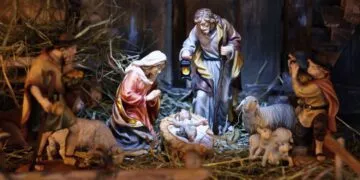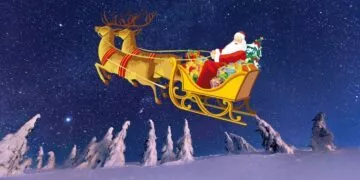There’s nothing more magical than the feeling you have when you wake up on Christmas day.
It’s an electrifying feeling that jumps you out of bed and gets you ready for a day full of presents, food, and festivities!
Now everyone knows the general story of Christmas, so we won’t go into that.
Instead, we’ve prepared a magical list of some of the lesser-known facts about Christmas!
Do you know where your Christmas traditions come from? Or your favorite Christmas characters and foods?
Maybe you want to know what the world’s most expensive Christmas tree is.
Well, that’s what we’re here to find out! So let’s get started with these 100 festive facts to get you ready for Christmas!
Scientists calculated that for Santa to deliver presents to every home in the world, he would have to travel at a speed of 4,921,200 miles per hour!

That’s 7,919,904 km/h for those who favor the metric system.
There are a number of factors that are involved in this calculation.
Give or take, there are around 1.6 billion households across the world. It’s been calculated that only around 31% of households are actually visited by Santa, which means he has about 500 million stops to make on Christmas Eve.
Santa would have about 42 hours to complete his task due to international time zones and other things.
During this time, he has to travel from house to house, depositing gifts, snacking on a cookie or two, and of course, remaining completely undetected.
For this to be possible, Santa would have to stop at each household for only 300 microseconds (that’s 0.0003 seconds!).
For 13 years, between 1647 and 1660, Christmas was banned in the UK by Cromwell after the English Civil War.
Our needley favorite, the Christmas tree, doesn’t need to be thrown away every year; some parts are edible, including the needles themselves, which are a source of Vitamin C.
The holly inside a wreath actually represents Jesus’ Crown, and the red berries represent his blood.
In 2015, the world’s first Christmas card commissioned by Sir Henry Cole in 1843 sold for £8,469 ($10,513.84). The hand-colored card pictured a family drinking wine.
The star of Bethlehem that guided the wise men is believed to be a comet or Uranus.
Our favorite pudding, the Christmas pudding, was initially a soup made with raisins and wine.
Edward Johnson invented the first electric tree lights in 1882.
The first Christmas was supposedly held in York, the UK, in 521AD.
It turns out that it’s extremely unlikely that Jesus was born in a stable!
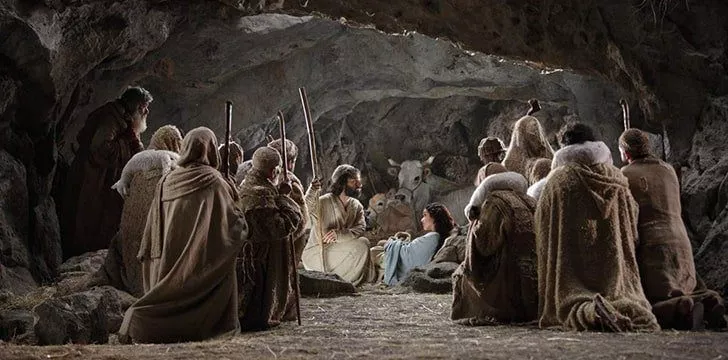
As most of you should know, Christmas isn’t just about gifts but is primarily about celebrating the birth of Jesus Christ.
For a long time, people have believed that Christ was born in a stable as the inn that Mary and Joseph called had no room.
Christian scholars have analyzed the story in great detail and have discovered that there was likely no inn at all!
Instead, the place they visited was likely a family home.
During this period in Bethlehem, the houses were generally built with two stories: the ground floor was used for housing animals, while the upper floor was used as the actual residence.
The theories go on to state that due to the upper floor already being full, the lower floor (where the animals were kept) was actually the site of Jesus Christ’s birth!
The Christmas-card staple, the red robin, was originally a joke mocking postman who wore red tunics. These postmen were known as robins.
Noel actually comes from the French phrase “les bonnes nouvelles” or “the good news.”
Many people’s favorite carol, “Jingle Bells,” written in 1857, was actually written for thanksgiving and was called “on horse open sleigh!”
Turkey wasn’t always the Christmas go-to; England’s traditional meal of choice was actually a pig’s head and mustard.
Santa Claus has worn many colors in his time, including blue, green, white, and red. The red suit came about when Coca-Cola had an advertisement campaign in the ’30s.
The word Christmas comes from the old English meaning Christ’s mass (Cristes maesse).
The first Christmas crackers were made in London in 1847 by Tom Smith.
The term “Boxing Day” is supposed to come from the money raised for the poor in church alms-boxes.
The Beatles had Christmas number ones in 1963, 64, 65, and 67, giving them the record for the most Christmas number ones.
Rudolph the Red-Nosed Reindeer has only been around since 1939!
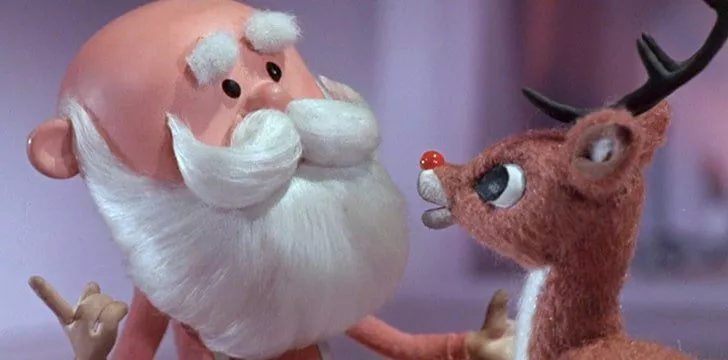
The story of Santa’s sleigh being pulled by reindeer has been around for a while, but Rudolph only joined the gang in 1939.
Rudolph was created by Robert L. May for the retailer Montgomery Ward, who gave out coloring books every Christmas.
While coming up with the initial concept, he briefly considered calling the friendly little reindeer Rollo or even Reginald!
The story of Rudolph the Red-Nosed Reindeer was rejected at first because back in the 1930s, a red nose was considered to be a sign of a drunkard!
The gold chocolate coins we receive at Christmas are to represent the gold St Nicholas supposedly gave to the poor.
Czech Republicans are very superstitious; a table at Christmas must be made of even numbers otherwise, the one without a partner will die.
In 1942 Irving Berlin wrote White Christmas. The Bing Crosby version sold over 100 million copies worldwide, making it the best-selling Christmas single of all time.
In December 1965, Jingle Bells was the first song broadcast in space from Gemini 6.
A white Christmas isn’t as unlikely as we all think in the UK; 1 in 10 is the chance of a traditional English White Christmas.
Santa Claus flying in the sleigh was an image dreamt up by the same man who created the headless horseman; the image was made in 1819.
Boxing Day is also celebrated as St. Stephen’s day.
Rudolph’s nose redness is hypothesized as a parasitic respiratory infection.
The first-ever artificial Christmas tree was a German tree made of dyed goose feathers.
In the “12 Days of Christmas”, all the gifts mentioned within the song add up to 364 gifts.

Honestly, if my true love gave me all the gifts that are mentioned within the “12 Days of Christmas,” we would have to sit down and have a serious conversation. Why?
To start with, when you count all the gifts mentioned (remember that with each recurring day, the previous day’s gifts are given again), there are a total of 364 gifts, which is just a bit much, isn’t it?
To add to that, who in the world could possibly need 12 partridges, 22 doves, 30 hens, 36 calling birds, 40 golden rings, 42 geese, 42 swans, 40 maids, 36 ladies, 30 lords, 22 pipers, and 11 drummers?
And what about the practicality of the gifts? You would need your own mansion to house it all!
To top it off, there’s the question of ethics – do you own all the maids, ladies, lords, and so on?
The last time I checked, the world had decided that slavery was definitely not an OK thing!
In the US, there are 3 Billion Christmas cards sold annually.
The average Christmas tree before its sale will grow for 15 years.
During the holiday period, around 28 sets of LEGO are sold per second.
In 1962 the first US Christmas postage stamp went on sale.
Eggnog apparently derives from “egg grog,” which means an egg and rum drink.
St Nicholas was originally a stern, harsh man holding a birch branch who symbolized discipline.
Milk and cookies derive from an Old Dutch tradition of leaving food for St Nicholas on feast day.
A Yule log is quite literally a giant log that is burnt during the 12 days of Christmas.
Christmas was first recognized in the US in 1836. The first state was Alabama, and the last was Oklahoma in 1970.
In the 1950s, church leaders in Boston tried to ban the song “I Saw Mommy Kissing Santa Claus” as it supposedly promoted physical intimacy.

Jimmy Boyd was just 13 years old when he recorded this instant classic in 1952.
The light-hearted Christmas tune sold 2 million copies within the first week of its release, but not everyone was fond of it.
A number of church leaders in the Boston region rejected the song as it mixed the concepts of physical intimacy with the pure concept of Christmas and attempted to have it banned.
Boyd ended up being flown to Boston, where he managed to successfully convince them of the song’s pure intentions!
Spider’s webs are traditional Polish Christmas decorations, as the spiders wove a blanket for Jesus.
Franklin Pierce, the 14th president of the US, was the first to place a Christmas tree in the White House in 1856.
In 2013, the record was set for the fastest time to decorate a Christmas tree. It took Sharon Juantuah 36.89 seconds and was set in Essex, UK.
Christmas hats, or paper crowns, are only worn in Britain during Christmas.
In Maria Carey’s “All I Want for Christmas Is You,” Santa Claus is played by Mariah’s then-husband Tommy Mottola.
Many believe that Christmas is a time with high suicide rates, but the real facts show spring is the worst.
Christmas trees are grown across all 50 states of the US.
During the Nazi era, Hitler tried to turn Christmas into a non-religious holiday celebrating Hitler, and Christmas trees were donned with swastikas.
Christmas tinsel was initially made of lead until the US government persuaded manufacturers to change it to plastic.
For an artificial Christmas tree to be more environmentally friendly than a real tree, you would need to reuse it for at least 10 years!

People have long debated whether buying a plastic Christmas tree is better for the environment than a real one, and we finally have some answers!
The deciding factor comes down to which type of tree you buy and whether you dispose of it properly or not.
A 3.3-foot (2 meters) Christmas tree with its roots still attached, when disposed of by burning it or planting it, only has a carbon footprint of around 7.7 pounds (3.5kg) of carbon dioxide.
A plastic Christmas tree of the same size has a much larger carbon footprint, measuring, on average, 88 pounds (40kg) of carbon dioxide!
In 1901, President Roosevelt banned Christmas trees in the White House.
Mistletoe comes from the mistletan, which means “little dung twig,” as its spreads through bird droppings.
Denny’s in America had an issue when it came to Christmas closing time, as many restaurants were built with no locks.
A middle-aged tradition is to eat a mince pie every day of the twelve days of Christmas as it supposedly gives you 12 months of good luck.
In Columbia in 2010, the government covered jungle trees in lights so that when guerrillas got near, the lights would illuminate, and banners appeared asking them to drop their weapons and reveal themselves.
A Boston industrialist closed his factory on Christmas Day and donated a turkey to all its workers after hearing Dickens’ A Christmas Carol.
In America, during 1659-81, Puritans banned Christmas with a fine of 5 shillings for each offense.
The most expensive Christmas tree was constructed in 2010. It was worth £6,975,880($8,660,206) and was on display at the Emirates Palace in Abu Dhabi. It had 181 pieces of jewelry adorning it.
Bicycle, a US Playing card manufacturer, created a card for all US POWs in Germany that, when wet, revealed escape routes. The card was given as a Christmas gift.
In Canada, letters sent to Santa go to postcode “H0H 0H0”.
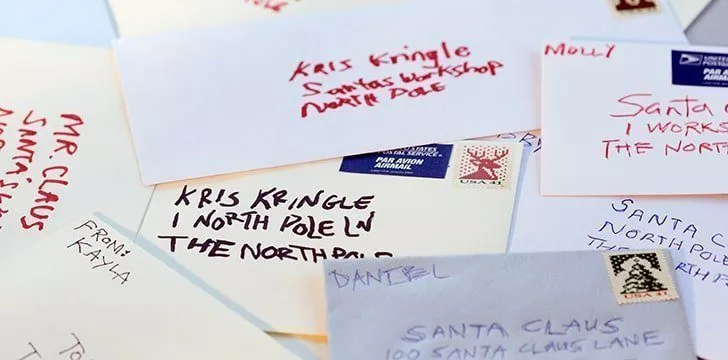
If you live in Canada and want to get a letter sent to Santa Clause, then you’re in luck – he has his very own postcode!
If you send a letter to him, make sure you send it before December 10th to ensure that he has time to reply to you.
If you’d like to send him one, his address is Santa Claus, North Pole, H0H 0H0, Canada.
The origin of the name Santa Claus has a convoluted tree. In Dutch St Nicholas became Sint-Niklaas or Sinter Klaas. Obviously, from there, it’s not a big leap to Santa Claus.
The concept of eggnog in America was apparently devised in 1607 at Captain John Smith’s Jamestown Settlement.
The Queen’s speech was first broadcast in 1957.
The World’s largest stollen measures 72.10m (236.55 ft) and was achieved in 2010. It was made by Lidl at Haarlem Railway Station in the Netherlands it took 2 and half hours to cook.
The candy cane at Christmas originates 250 years ago in Germany as straight white sticks.
Originally “Hark! How the Welkin rings!” were the lyrics for the much loved “Hark! The Herald Angel Sings” tune. Welkin meaning Heaven.
“Millionaires Crackers” are Christmas crackers that contain a solid silver box with a piece of jewelry inside.
Originally mince pies were actually filled with meat and were oval to represent Jesus’ manger.
The highest-grossing Christmas movie is actually Jim Carrey’s How the Grinch Stole Christmas.
It’s a tradition in Sweden to watch Donald Duck cartoons on Christmas Eve.

Every country has its own unique Christmas traditions, and Sweden is no exception!
Every year since 1959, Sweden’s main TV station, TV1, has broadcast an hour-long Christmas-themed Disney special, which includes short clips from various Disney Cartoons released between the ‘30s to the ‘60s.
Over time this tradition has evolved to the point that many Swedish families stop everything they are doing to sit down and watch the same cartoons every year.
In 1918, Canada sent a Christmas tree to Boston to show their appreciation for their help in the 1917 Halifax explosion. This gesture has been continued in recent times.
There is a debate that we actually give gifts at Christmas to commemorate the Pagan tradition of gifting the gods, not the three wise men.
Supposedly the Christmas pickle is to be the last ornament on the tree.
Some zoos around the world take Christmas trees that are donated to feed their animals.
In Japan, there is a tradition, thanks to a 40-year-old marketing campaign, that KFC is consumed by the vast majority of the population on Christmas Eve.
In November 2014, Birra Forst SpA created the world’s largest bauble with a diameter of 15ft (4.58m) and weighed 1060 lb (481kg).
Turkeys aren’t just for Christmas. June is National Turkey Lover’s Month.
The idea of a white Christmas comes from Dickens’ works. Dickens lived during a mini-ice age which meant every Christmas it snowed for 8 years straight.
The first decorated Christmas tree was supposedly in 1510 in Latvia.
The very first string of electric Christmas tree lights was created in 1882.

Up until the 20th Century, it was common for Christmas trees to be lit up with candles, something which was understandably quite dangerous!
The first electric Christmas tree lights were created by Thomas Edison’s business partner and friend, Edward H. Johnson, in 1882.
The cost involved in creating the lights and installing them was so high that they weren’t affordable to the general public until a few decades later.
That being said, Johnson’s Christmas tree was declared to be “the handsomest Christmas Tree in the United States.”
As of Christmas 2014, the world’s most expensive Christmas hamper costs £85,605! ($106,274.33) It includes a bottle of 1961 Moet, 250g (0.55 lb) of Almas Iranian Caviar, and Cognac Jules Robin 1789.
The Rockefeller Christmas tree is topped, as of 2004, with a 550-pound (249.48 kg) Swarovski Crystal star.
Calennig is a welsh tradition, like caroling, where children would go round houses singing with an ornate apple.
The tradition of Christmas crackers comes from an old French custom of giving gifts of paper-wrapped sugared almonds.
Turkey replaced Swan on the Christmas menu of the Royals in 1851.
In Scandinavia, the holly is known as Christ Thorn.
One superstition regarding Christmas pudding is that it shouldn’t have more than 13 ingredients to represent Jesus and his disciples.
In Dublin, in 1742, Handel’s Messiah was first performed. Messiah is a well-known oratorio, particularly at Christmas.
There are, traditionally, a range of trinkets left in Christmas pudding, including “Bachelors Button” (if found by a single man, he would be single for the following year), “Spinsters Thimble” (Same as Batchelor’s Button but for a single woman) and “a Ring” (any singleton who found this would get married the next year).
The “X” in X-Mas doesn’t mean what you might think it does!

There’s a common misconception that the replacement of Christ with the letter X in the word Christmas is an attempt to separate the concepts of Christ and Christmas, removing the religious side of the holiday.
It turns out that this couldn’t be more wrong!
In the Greek alphabet, the letter “chi” is written as “X, and it was actually used by Christian scholars as an abbreviation for Christ’s name.
So really, X-Mas actually means Christ-Mas, and as such, is no different at all!
In UK churches, the largest church bell rings an hour before midnight; at midnight, all others are rang in celebration.
In the US, there are 2 places known as Santa Claus and Santa, they are in Indiana and Idaho, respectively.
Since 1991, real Christmas tree sales have plummeted below that of artificial trees.
The Christmas carol “Silent Night” originated in Austria; it was played on a guitar as the organ was too rusted.
Coca-Cola’s big red Christmas truck visits more than 40 locations across the UK every year.
Christmas crackers were originally called “cosaques” and are supposedly named after the Cossack Soldiers who would fire their guns into the air on horseback.
On Christmas Day 2011, there were 6.8 million iOS, and Android devices activated.
In 2013, 1.7 million people sent Santa letters, which’s the highest percentage of over 8 million letters sent worldwide.
The traditional Christmas Eve meal in Armenia is a portion of fried fish, some lettuce, and spinach.
Michigan has no state song apart from an old song written to the Christmas song “O Tannenbaum,” which had the lyrics “Michigan, My Michigan.”
Well, there are your 100 festive facts. We hope you’re feeling more festive now.
We hope that you’ve come away from this not only entertained but informed too!
Now the next time there’s an awkward silence at the Christmas dinner table, you can pull out one of these fabulously festive facts to wow your family.




